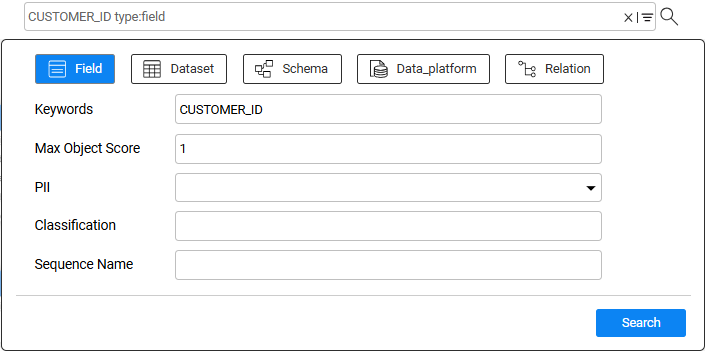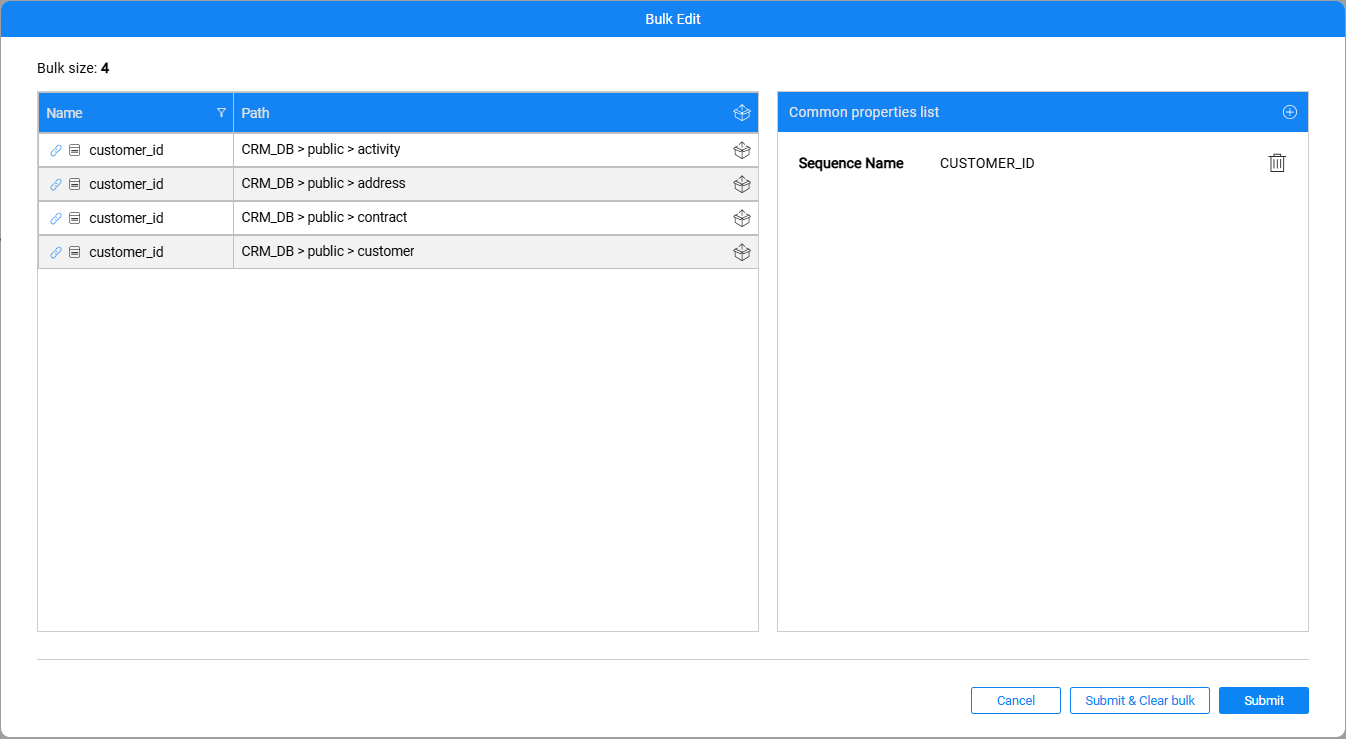TDM — Catalog-based Sequence Implementation
Fabric has added the Sequences tab to the Catalog. This tab allows to set up the sequences that can be generated in a project by population flows or other flows.
Steps for Catalog-based Sequence Implementation
I. Catalog — Populating the Sequences Tab
Populating the Sequences tab involves adding the Sequence Classification and setting the data Generator for each sequence.
Click here for instructions.
II. Catalog — Adding Sequence Classification to Tables
Currently, the Catalog does not automatically identify the sequence fields. Therefore, after a list of sequences is set in the Sequences tab, the relevant Catalog fields should be manually marked as sequences. Build the Catalog artifacts when completing the manual updates.
Note that you must run the discovery on the interface that is populated in the TDMLUInitBasedOnFabric flow's TARGET_INTERFACE input parameter, since the load flow, created by the TDMLUInitBasedOnFabric flow, sends the TARGET_INTERFACE value to the HandleMaskAndSeqFields flow, which applies masking and sequence replacements to every record before loading it into the target environment.
Click here for instructions.
The Catalog feature of Bulk Edit is supported from Fabric V8.3 onwards. This feature simplifies adding a Sequence Name property to specified fields (such as unique IDs), since you can create a bulk of fields for each Sequence Name and update the fields accordingly. A separate bulk needs to be created for each Sequence Name.
Example: Adding the CUSTOMER_ID Sequence to all fields named 'CUSTOMER_ID' in the CRM DB:
Search for fields named CUSTOMER_ID:

Select the relevant fields and add them to the bulk:

Close the Search window (click the X on the Search box) and edit the bulk: Add the CUSTOMER_ID Sequence to this bulk and click the Submit & Clear bulk button.

The CUSTOMER_ID Sequence is added to all the bulk's fields and the bulk is cleared.
You can now repeat these steps for additional Sequences (such as CONRTACT_ID).
Click here for additional instructions on how to edit a bulk of entities in the Catalog.
III. TDM Implementation Changes
Run the TDMLUInitBasedOnFabric flow to regenerate the load and rule-based data generation flows.
For each LU that requires sequences to be populated by the Catalog, add the TDM_USING_CATALOG_SEQUENCES Global. Set this Global to true.
TDM — Catalog-based Sequence Implementation
Fabric has added the Sequences tab to the Catalog. This tab allows to set up the sequences that can be generated in a project by population flows or other flows.
Steps for Catalog-based Sequence Implementation
I. Catalog — Populating the Sequences Tab
Populating the Sequences tab involves adding the Sequence Classification and setting the data Generator for each sequence.
Click here for instructions.
II. Catalog — Adding Sequence Classification to Tables
Currently, the Catalog does not automatically identify the sequence fields. Therefore, after a list of sequences is set in the Sequences tab, the relevant Catalog fields should be manually marked as sequences. Build the Catalog artifacts when completing the manual updates.
Note that you must run the discovery on the interface that is populated in the TDMLUInitBasedOnFabric flow's TARGET_INTERFACE input parameter, since the load flow, created by the TDMLUInitBasedOnFabric flow, sends the TARGET_INTERFACE value to the HandleMaskAndSeqFields flow, which applies masking and sequence replacements to every record before loading it into the target environment.
Click here for instructions.
The Catalog feature of Bulk Edit is supported from Fabric V8.3 onwards. This feature simplifies adding a Sequence Name property to specified fields (such as unique IDs), since you can create a bulk of fields for each Sequence Name and update the fields accordingly. A separate bulk needs to be created for each Sequence Name.
Example: Adding the CUSTOMER_ID Sequence to all fields named 'CUSTOMER_ID' in the CRM DB:
Search for fields named CUSTOMER_ID:

Select the relevant fields and add them to the bulk:

Close the Search window (click the X on the Search box) and edit the bulk: Add the CUSTOMER_ID Sequence to this bulk and click the Submit & Clear bulk button.

The CUSTOMER_ID Sequence is added to all the bulk's fields and the bulk is cleared.
You can now repeat these steps for additional Sequences (such as CONRTACT_ID).
Click here for additional instructions on how to edit a bulk of entities in the Catalog.
III. TDM Implementation Changes
Run the TDMLUInitBasedOnFabric flow to regenerate the load and rule-based data generation flows.
For each LU that requires sequences to be populated by the Catalog, add the TDM_USING_CATALOG_SEQUENCES Global. Set this Global to true.



